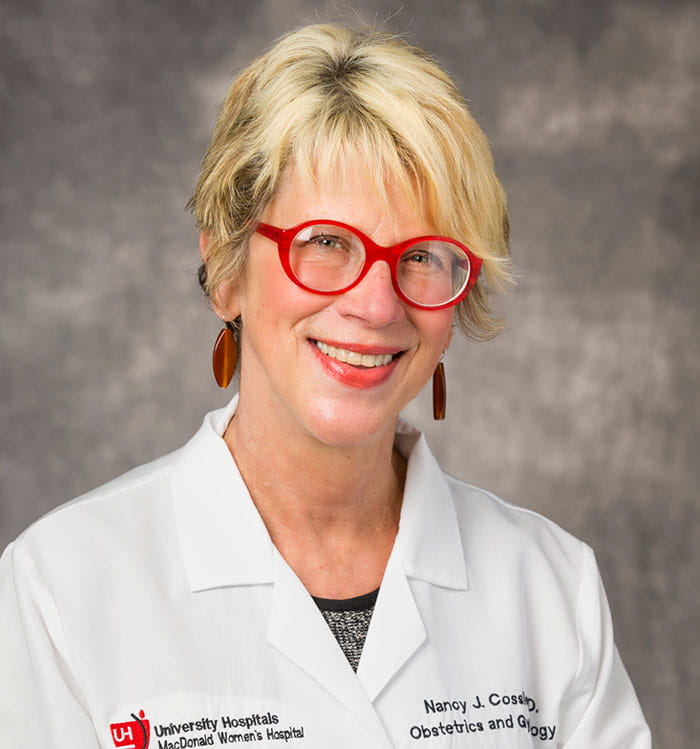UH OB Quality Network Combating Persistent Problem of Maternal Mortality and Morbidity
April 23, 2024
UH Clinical Update | April 2024
 Nancy Cossler, MD
Nancy Cossler, MDEven in the midst of the opioid crisis, prescribing narcotics for pain to women who’ve had a cesarean birth has been a difficult practice to change. However, this crucial adjustment in care is now well-established across the UH OB Quality Network, says Nancy Cossler, MD, Chief of System Quality for Obstetrics at University Hospitals and Vice Chair, Quality & Patient Safety at UH MacDonald Women's Hospital.
“We had to reorder all of what we think we know,” she says. “Narcotics for so long were considered the gold standard for severe pain. They're not. Acetaminophen and NSAIDs together are just as good. Patients take it on a schedule.”
“We knew that exposure to opioids at the time of delivery led to 6% of women having continued opioid exposure after discharge,” Dr. Cossler says. “We had to do everything we could to take opioids out of our postpartum care as a way of dealing with pain, and we have been very successful. We've made great strides.”
The new paradigm required changing the minds of patients, nurses, physicians and other clinicians involved in the care of patients following cesarean birth, says Marcie Niemi, DNP, RNC-OB, APRN for Perinatal Nursing Research and Development.
“We realized, because it was a change in practice, we had to do a lot of clinical education and reinforcement for our nursing staff and our providers to really believe,” she says. “We also implemented additional patient education, posting signs in the room about postpartum comfort measures, making sure patients had supplies to promote comfort like abdominal binders, pillows, supportive positioning tools, hot packs and cool packs. We needed to ensure those tools were available for patients to promote comfort and drive down pain.”
Results show the approach is working. Dr. Niemi and the OB Network Quality Team led a quality improvement initiative to document the effects of their multi-pronged strategy. The team found that inpatient oxycodone usage for breakthrough pain fell from 86% before the intervention to a current rate of 58%.
Both Dr. Cossler and Dr. Niemi are gratified by these results – because of what they mean for the ongoing campaign to address maternal mortality and morbidity.
Other Projects to Boost OB Quality
The effort around opioids is certainly not the only quality initiative being implemented across the UH OB Quality Network. Select projects include a high-alert double check before oxytocin is administered to a patient after vaginal delivery and a project focused on timely treatment of severe hypertension in obstetrical patients, among others.
In a different vein, nurse practitioner Shannon Weems, WHNP-BC, is filling a new role, coordinating care for complex and high-risk OB patients. She manages patients who are simultaneously seeing different providers, tracks down those who may have missed scheduled appointments and convenes monthly maternal care meetings focused on complex and high-risk patients – and not just those exclusively from maternal-fetal medicine.
“That includes the hospitalists, who will likely run into these patients with delivery,” she says. “We've invited specialty providers and it’s made for a smoother process in terms of delivering excellent care. We can have this conversation quickly and talk about the patient and review everything. Then everyone's aware of the plan.”
Different Approaches for Different Patients
Another key effort is around sepsis. Dr. Cossler says it’s a much different condition for the postpartum patient than it is for other sepsis patients.
The triggers for sepsis, the vital signs they use, vary from the normal, usual adult patient, she says, such as changes in blood pressure and respiratory rate.
After several years of sepsis education for OB providers, the UH OB Quality Network introduced new OB sepsis triggers into the Epic platform last fall.
“We had to,” Dr. Cossler says. “We have distinct sources. We have to write separate antibiotics. Also, the physiologic changes of pregnancy and labor can complicate the diagnosis of OB sepsis. Pregnant and recently delivered patients, therefore, have sepsis screening criteria that differ from the general adult population including vital sign and laboratory parameters unique to our patients.“
Plus, she says, a young postpartum patient suffering from sepsis can look deceptively healthy – until they’re not. It’s crucial to give providers the tools they need to recognize the warning signs, -- not a small undertaking, and one not limited to just her OB/GYN colleagues.
“It takes skills to teach people that,” Dr. Cossler says. “Many of these patients with sepsis may be presenting to the ED at our hospitals and not to labor and delivery. It’s really a huge project of provider education and collaboration.”


